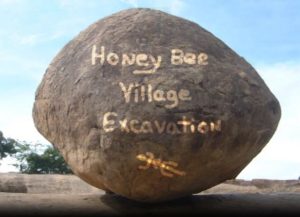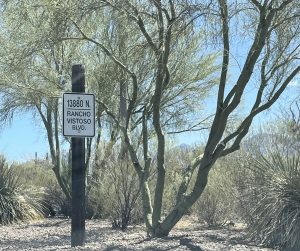

Petroglyphs - What are they and where can you find them in Oro Valley?

Honey Bee Canyon Park – Discover Petroglyphs! Want to find this petroglyph? Scroll down the page for helpful tips!
Centuries before modern Oro Valley, Indigenous peoples carved symbols and images into stone, leaving behind a rich record of life in the desert. These petroglyphs offer a lasting glimpse into their culture, beliefs, and connection to the land.
Imagine Native Peoples of the past surveying the world around them, wildlife, rivers, plant life, the night sky and other people. It would have been natural to feel the need to communicate that beauty and save it for others along with more important aspects such as equinox events to ascertain when to plant crops, etc.
See this petroglyph from the Santa Catalina Mountains in the Pusch House Museum at Steam Pump Ranch!
Henry (Hank) Zipf (1916 – 2015) was a long-time Oro Valley resident. He worked as a local attorney and contributed to the early years of the Town of Oro Valley’s development.
Hank was the grandson of George and Mathilda Pusch, early area pioneers, who established Steam Pump Ranch in the late 1870s. Books, records, photographs and other Pusch family memorabilia from the late 1800s and early 1900s were kept by Gertrude Pusch Zipf, Hank’s mother. These materials were in turn preserved by Hank as part of his family legacy which he highly valued. They now make up the heart of the Oro Valley Historical Society collections.
In the 1970s Hank and his son, Henry K. Zipf (1956 – 2023) rode horseback along the foothills, washes and outcrops of the Santa Catalina Mountains looking for artifacts. Archaeology was a lifelong interest of Hank’s having spent time at Steam Pump Ranch in his youth. Hank had knowledge of the Native Americans who lived in the vicinity of the ranch through his mother, Gertrude’s, stories.
On one of their rides, Hank and Henry discovered various Native American artifacts. With permission from the landowner, they collected three bedrock mortars (used as food grinding implements), and a petroglyph. Hank kept these artifacts for the remainder of his life, moving them from his home in Oro Valley, to Sonoita, and finally Tubac.
Late in life, Hank told his adult children that he wanted the mortars and petroglyph to be donated to the Oro Valley Historical Society and placed near the Santa Catalina Mountains where they were originally found.
In 2016, after Hank’s death, Henry K. and his sons, Stephen and Nolan, transported the artifacts to the Steam Pump Ranch Historical Park. With the permission of the Town of Oro Valley (owner of Steam Pump Ranch), the mortars were placed in the Heritage Garden. The mortars, along with the petroglyph, are used in school and community programs to educate about the cultural heritage of the Hohokam People who once inhabited the area.

Honey Bee Village Excavation Video with Henry Wallace of Desert Archaeology.
Watch excavations of AD 1000 Hohokam homes and discover how this agricultural society lived through the items and structures they left behind. In this video, Henry Wallace, Senior Research Archaeologist with Desert Archaeology, Inc., provides information about the Hohokam people and their life at Honey Bee Canyon, and the excavation of their village
Preservation of the core area of one of these Hohokam villages is essential to gaining a better understanding of the thousands of years of history in Oro Valley. Archaeological excavations were conducted at the site in 1988.
Preservation of the core area of one of these Hohokam villages is essential to gaining a better understanding of the thousands of years of history in Oro Valley.
Go to our video library to find more historic information.

Entrance to Honey Bee Canyon Park off N. Rancho Visto Blvd.
The petroglyphs are easy to miss—they’re not on the trail loop. Follow these steps for a successful visit:
Park on the east side of Rancho Vistoso Blvd. (accessible only when driving northeast).
From the lot, take the far-right sidewalk toward the direction sign, not the arched entry on the left. Follow the ramp with the railing.
At the end of the walk (restrooms on the left), turn right toward the dirt trail. Do not continue on the cement sidewalk.
Head toward the Rancho Vistoso overpass and enter the wash beneath it.
Walk about 1 mile—flat, sandy terrain.

Man-Made Rock Dam Indicates that You’re Close to the Petroglyph!
Pass the man-made rock ‘dam’. Just beyond, approximately 100 yards, look left for a large stone balanced on another at eye level.
If you get to the trough and the “new dam”, turn around; you’ve gone too far! Happy trekking!